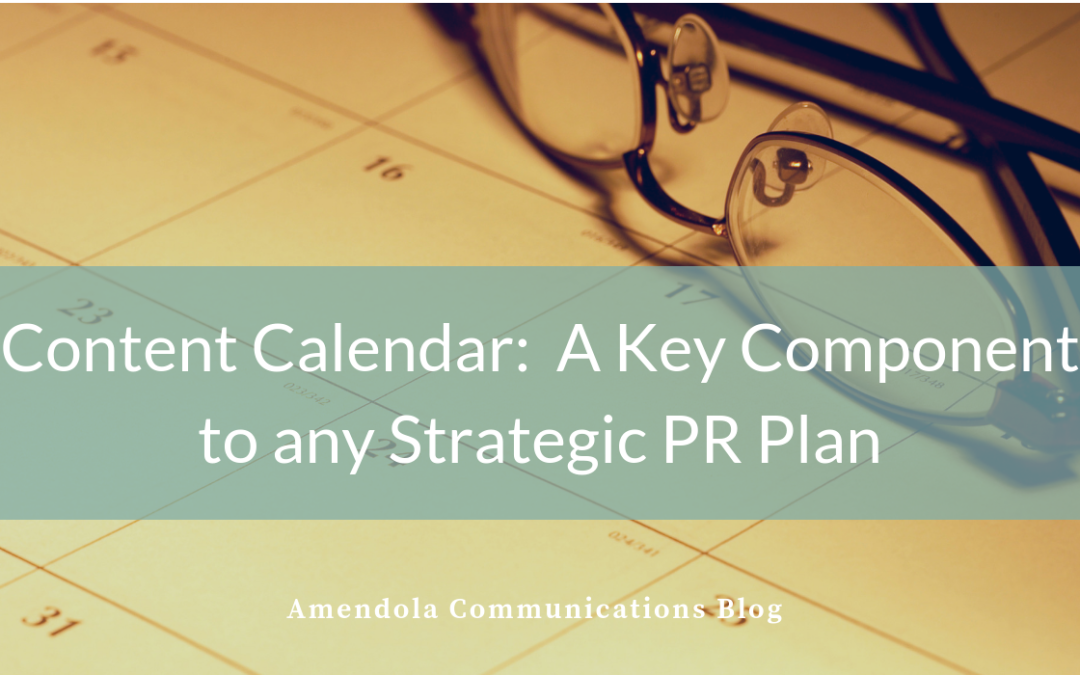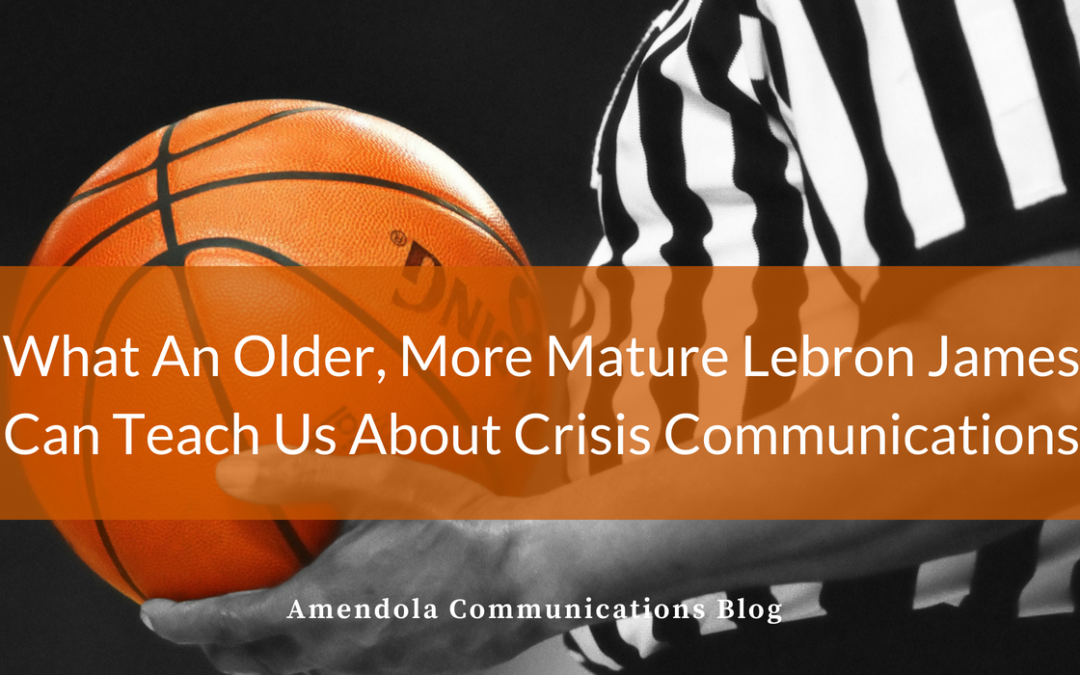
by Linda Healan | Oct 31, 2018 | Blog
Oftentimes public relations professionals think of content calendars as a tool for marketing communications programs. Having an internal editorial calendar is absolutely important for any content program. Since an integrated public relations campaign has evolved from just media relations, PR pros should also consider a content calendar as part of their overall strategic PR plan.
Knowing your audience(s) is one of the primary tenants of public relations, and the purpose of any good content is to engage, educate and encourage action. Therefore, it is necessary for us to identify those people who really are influential and approach them through high-quality content rather than corporate or product blurbs.
It is also essential to make sure that a content calendar is developed based on your overall marketing goals. What do you want to accomplish this year? What new products will be announced? Are you a start-up just entering the market or are you positioning for an IPO, other investments or hoping for an exit strategy? Positioning your executives as subject matter experts and/or thought leaders is always a good strategy in any PR Plan.
So, what should be incorporated into a public relations content calendar to reach appropriate audiences and support marketing objectives?
Events
Events are one of the best opportunities to make your public relations strategy successful, whether it is through external trade shows such as HIMSS or other health/medical conferences or internal events such as webinars and user groups. Listing upcoming events in your content calendar allows you to develop content that strategically targets potential buyers as well as current customers, and position executives and thought leaders, all based on the timeline for the events. You can tie press releases and customer case studies to events, announce executive speakers or even blog about your giveaways at a trade show.
Press Releases
A well accepted strategy in PR is to average one press release every month. This allows you to keep your name and messaging top of mind and fresh with reporters. Scheduling your press releases in advance of industry events and around product launches helps your PR team coordinate with your marketing team to make sure the news is ready to be disseminated at the right time.
Articles/Case Studies
Thought leadership articles and case studies are excellent tools in the arsenal of any PR professional to demonstrate your knowledge and experience. Planning to develop these types of articles in your content calendar and then pitching for placement in key media outlets is the kind of valuable coverage many organizations desire. Compare the articles you plan to develop to the next category editorial opportunity calendars and you’ve got a head start on content that can be published.
Editorial Opportunity Calendars
Years ago, editorial opportunity calendars were the bread and butter in any PR campaign. With the move towards online media, many publications no longer publish or adhere to editorial calendars. But some still do and researching those calendars and adding key opportunities to your PR content calendar allows you to develop content in a timely basis to pitch to those media outlets. Make sure, however, that you build in lead times into your calendar. Another benefit to editorial calendars is they give you an idea of what topics the media is interested in covering and can help you develop a list of content ideas for the year.
Other categories that can be included in an integrated PR content calendar are blogs, customer newsletters and social media outreach. There are plenty of free tools on the web that you can use to develop a content calendar.
In the end, it all works together. Having a calendar of events, press releases and editorial opportunities allows a public relations professional to strategically plan to develop content that meets deadlines, achieves marketing goals and engages, educates and encourages action from your key audiences.

by Brandon Glenn | Aug 8, 2018 | Blog
In most cities, a sports star leaving to join another team wouldn’t quite reach the level of crisis. No doubt, the world has countless far more serious and urgent problems.
But Cleveland’s a little different than most cities. Egos are a bit more fragile here after decades of job loss, population decline, environmental damage, and not to mention sports ineptitude or so it seems to this (humble) outsider who first moved to Cleveland about a decade ago.
So after the Cleveland Cavaliers drubbing yet again at the hands of the Golden State Warriors in the NBA Finals in June, coupled with LeBron James impending free agency, thing were looking pretty bad for Cleveland. Despite hailing from nearby Akron and enjoying close ties with the local community, LeBron looked likely to depart Cleveland for a sexier, more glamourous destination, leaving the locals he left in his wake feeling abandoned and forgotten.
Unfortunately, that’s exactly what happened. But to LeBron’s credit, he learned from a past mistake, and let Cleveland fans down a little easier this time, while simultaneously providing a lesson on crisis communications.
We’ve seen this movie before
The date of “The Decision” by James – July 8, 2010 is one that lives in Cleveland sports infamy. On that night, the then-25-year-old who is perhaps the greatest sports star the city has ever known crushed his hometown fans by announcing on live TV his intention to “take my talents to South Beach and join the Miami Heat.” Next came the reaction. A city mourned, jerseys were burned, insults were hurled, and one melodramatic fan called it “the worst day of my life.”
Later that night, Cavaliers Owner Dan Gilbert hastily published a scathing open letter notoriously printed in comic sans font excoriating James for a “several-day, narcissistic, self-promotional build-up culminating with a national TV special.” Illustrating that Gilbert’s PR team had ready access to a thesaurus, the irate owner peppered his letter with several enjoyable descriptions of James and his decision, including “cowardly betrayal,” “shameful display of selfishness,” “shocking act of disloyalty,” and “heartless and callous action.”
To be clear, the majority of Cleveland fans weren’t angry at James for signing with Miami; they were upset by the “needless pain” he inflicted on the city for the spectacle of “The Decision,” which I recall one commentator comparing to a newly minted millionaire going on national tv to tell his high-school sweetheart he’s dumping her to move in with a supermodel.
Indeed, players change teams all the time (LeBron has now done it three times) “but no player has ever done it with the pomp, phoniness, pseudo-humility, and rehearsed innocence” as James, as a Chicago Sun-Times columnist correctly observed. That’s what understandably perturbed Cleveland fans, and later provided James with an opportunity to show growth in his style of public communication.
A second chance
After James spent four seasons in Miami and won two championships while making the NBA Finals every year, in 2014 he did what was once unthinkable. He mended fences (kind of) with Gilbert, rejoined the Cavs and led the city to its first major professional sports championship since 1964.
Then James broke Cleveland’s heart all over again. On July 1, 2018, the now-33-year-old James announced he was leaving the Cavaliers once more, having signed with the Los Angeles Lakers.
But this time it was different no self-serving, nationally televised special; no week-long buildup of drama and, thankfully, no jersey burnings or lamentations about the worst day of fans lives. James and his advisors simply delivered the news in 36-word press release:
LeBron James, four time NBA MVP, three time NBA finals MVP, fourteen time NBA All Star, and two time Olympic gold medalist has agreed to a four year, $154 million contract with the Los Angeles Lakers.
While unnecessarily trumpeting his major accomplishments on the court isn’t the height of modesty, James deserves credit for learning from his mistakes and rolling out his latest “decision” in a far more muted, low-key fashion.
And that brings us to what we can learn from James in crisis communications: Be brief, take responsibility, get to the point and don’t sugarcoat things.
While this is a lesson that apparently took James eight years to learn, healthcare organizations can learn from his mistakes by never committing them in the first place.
And it’s probably best to avoid ever proclaiming that you’re taking your talents anywhere.

by Heather Caouette | Apr 12, 2017 | Blog
Swiss Army knives are generally thought of as the go-to multi-tool, capable of performing all sorts of handy functions in one neat little package. Marketers have their own version of the Swiss Army knife: the press release. It has the versatility to advance a variety of marketing goals.
That was not the case several years ago. Back then, press releases were written for the media; hence the name. Today the internet, social media and business practices have blurred the lines, which means in many cases a press release is no longer written with the sole purpose to attract media attention or fulfill an SEC guideline. Instead, it is a multi-function business tool.
Press releases allow you get your message out to your audiences unfiltered. This one piece of collateral is completely versatile and can help companies work towards a plethora of goals, including:
- Media relations: Good, solid media relations. Through distribution services, press releases are sent to journalists’ email, where they can choose to write about the news. Even if the reporter does not cover the announcement right away, your information may be filed as a “source” for future articles. The exposure can also make journalists aware of your company, or keep them informed about your latest developments.
- Sales: Current projections estimate that 60% to 70% of the business buyer’s purchase process is made before they contact the vendor. Given that most information a prospect obtains is before they enter the sales funnel, you need ways to reach them earlier in the purchasing journey. Also, press releases can be a reason for the sales team to go back to a prospect. Customer wins may be shared with prospective client of a similar size, specialty and/or location. Many deals are completed by potential customers after seeing what their peers are doing.
- Attract New Talent: Who does not want to work for a company that is doing exciting and innovative things? Showing momentum can turn the heads of qualified candidates for even hard to fill spots.
- Keep Investors in the Know: Highlighting your successes can attract investors. A steady cadence of news signals an active company that is gaining traction, a key to obtaining investor interest.
- SEO Benefits: When credible websites and search engines pick up your press release, it can raise your placement in Google search results, which drives traffic and increases awareness for your site. Using specific keywords can optimize the press release to be easily searchable by audiences, including prospective and current customers, employees, investors and the media.
You can significantly increase interest in your press releases by adding images or video, making them even more beneficial. Which business objectives will they help you unlock?


